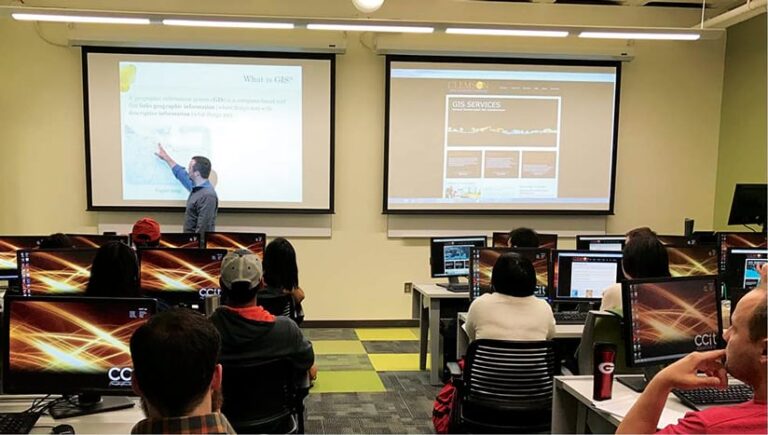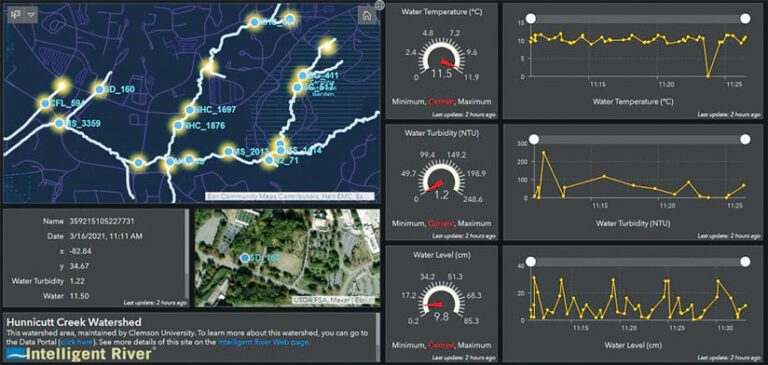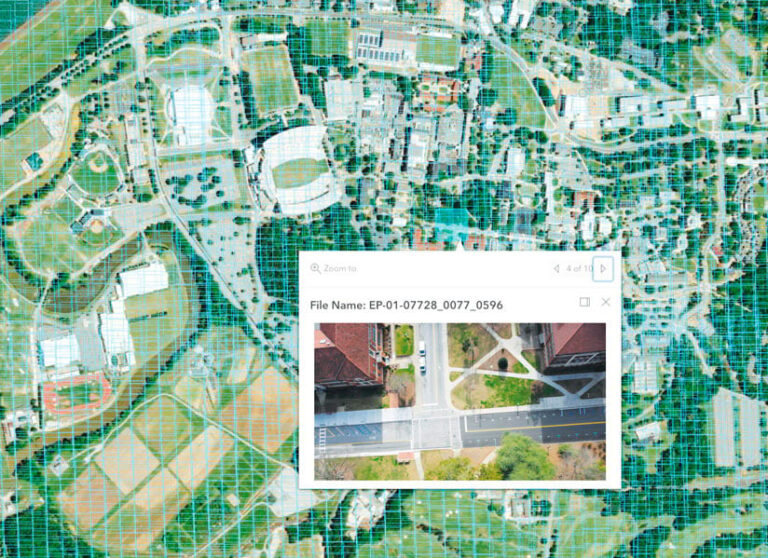Growing global challenges, including climate change, need creative solutions. Institutions of higher education are increasingly playing a vital role in empowering future generations with the knowledge, skills, tools, and interdisciplinary collaboration necessary to produce innovative outcomes.
Clemson University is doing so by integrating geospatial technologies within diverse academic disciplines. The Clemson Center for Geospatial Technologies (CCGT), established in 2016, fosters a community of interdisciplinary geospatial science practitioners through the support of research, teaching, and outreach activities. CCGT assists students, faculty, and researchers to leverage GIS technology within their disciplines and bridge global connections among academic, industrial, government, and nongovernmental organizations worldwide.

Centrally located in Clemson’s Cooper Library, CCGT hosts upward of 3,000 people a year and teaches 11 workshops per semester that provide participants with a basic understanding of GIS. In addition, CCGT serves as a resource when geospatial services are needed, including offering drone imagery, mapping, and analytics services university-wide. Departments such as Agriculture, Automobile Engineering, Athletics, and Campus Operations have participated.
“This model has been a game changer in terms of collaboration to eliminate data redundancy and lower costs,” said Patricia Carbajales-Dale, executive director of CCGT.
In seven years, CCGT staff have leveraged workshops, word-of-mouth messaging, departmental collaborations, campus events, and more to make the center what it is today: a valuable academic and operational resource. Currently, the center employs six staff members and offers internship roles. It also facilitates workshops led by student collaborators and members of the IT department.
“We have a great relationship with our students and faculty, and for me, that is where our support starts,” said Carbajales-Dale. “[CCGT] is a service, and our job is to support people at Clemson.”
IT Staff and Librarians Partner to Start Geospatial Technology Center
The journey to creating CCGT began in 2014 as a collaboration between the IT department and librarians to ensure that GIS more widely benefited the campus. At the time, the university had an enterprise license agreement and seven labs dedicated to geospatial equipment. Departments such as Environmental Engineering, Forestry, and Geology were primarily benefiting from GIS.
“Clemson University had a lot of investments in GIS, remote sensing, [and] exclusive labs, but no one to directly support it. The technology was falling into the hands of faculty, who were very overwhelmed,” said Carbajales-Dale. “The chief information officer at the time had this vision to add a human component to the investment to make the most of the technology for the community.”
That human component was Carbajales-Dale, hired in 2014 as a facilitator to ensure the technologies’ impact grew campus-wide. To expand this vision, Carbajales-Dale first offered basic GIS workshops on campus for students and faculty. The courses had high attendance rates and offered opportunities for Carbajales-Dale to learn from others where GIS support could enhance campus learning.

“Some departments didn’t have faculty but wanted a semester-long course taught. Some faculty needed support to stay up-to-date on the technology, while students needed help with a thesis or for undergraduate research,” Carbajales-Dale said. “Our solution needed to offer flexible support, [and] we needed to show some sort of sustainability. So we created the center.”
Getting Buy-In Took Time and a Tailored Approach
CCGT received funding for three years with the intent to become self-sufficient through cost sharing of equipment, licenses, drone insurance, and more. CCGT staff began building a sustainable foundation by nurturing buy-in with various faculty members, students, and other departments to find collaborative opportunities that met the needs of the university.
“Buy-in doesn’t happen overnight,” said Carbajales-Dale. “It took a few years. But we started with faculty, and we showed them by doing the things they needed that we were there to support them. They’re our biggest champions.”
Carbajales-Dale noted that CCGT staff members overcame buy-in challenges by tailoring their approach to understand the users’ end needs. Often this meant meeting with department chairs, lecturers, or students one-on-one to understand what technology they could benefit from in their disciplines—or even developing example syllabi.
By 2017, the center’s popularity had grown, and staff members introduced a cost-sharing model through strategic partnerships with other departments. This new model moved the center toward self-sustainability while empowering staff to maintain specialized equipment and develop new support programs for unmanned aerial vehicles (UAV) and lidar technology. By having the center and departments share costs, geospatial and imagery requests are fulfilled within the university instead of being outsourced.
Most recently, the center and several other university departments contributed to the costs of a drone imagery project spanning the entire campus. Over 12 days, more than 7,000 high-resolution aerial photos were captured. The detailed aerial view of the campus allows departments such as facilities to see where maintenance is needed. Moreover, CCGT staff used Clemson’s Palmetto Cluster supercomputer to process the images and generate GIS products such as orthomosaics and digital surface models.
“This partnership between two very centralized units—the libraries and IT—I believe, has given the center the best of both worlds,” added Carbajales-Dale.
We are beyond proud for making GIS approachable and less intimidating to all disciplines across our campus.
In addition to the work CCGT provides across campus, Clemson University is a land grant institution, meaning staff provide public services and research across the state. For example, Clemson University was awarded $3 million by the National Science Foundation (NSF) Major Research Instrumentation (MRI) Program to support the Intelligent River project. The project entails designing, developing, and deploying a basin-wide network of computerized sensors to monitor water quality along the 312-mile Savannah River. CCGT staff will be using ArcGIS to help the 40 scientists on the project visualize and monitor real-time data collected from the sensors.
Enhancing GIS Curriculum via Coteaching and Centralized Resources
Today, CCGT provides a range of services to faculty, students, administration, and campus operations. Services include GIS fundamentals; course development; weekly workshops; outreach activities; field data collection; and access to drones, 3D printers, lidar, and UAVs.
From the classroom perspective, CCGT supports six to eight classes per semester by providing workshops, lectures, or training related to the subject matter in a coteaching setup with the faculty member. Disciplines such as architecture, forestry, geology, and natural resources regularly incorporate CCGT as a resource. As part of ongoing efforts to make GIS more accessible to students in disciplines outside technology and science, CCGT staff members have offered curriculum support, consultations, and training sessions for social sciences and humanities programs. These efforts have led departments such as Anthropology, Sociology, History, and Public Health to bring GIS into the classroom.
“We are beyond proud for making GIS approachable and less intimidating to all disciplines across our campus,” said Elham Masoomkhah, former GIS manager at Clemson University. “Through CCGT support efforts, we have developed our GIS community from the ground up. We are humbled by an enormously increased demand for our services and are doing our best to answer the needs of our GIS community.”
One example of CCGT’s outreach to other disciplines is a course cotaught by Carbajales-Dale and Natallia Sianko, assistant professor in the Department of Sociology, Anthropology, and Criminal Justice at Clemson University. The class—Globalization & Social Change: Intro to GIS for Public Health, Visualization for the Social Sciences—is an interdisciplinary approach to teaching students theory and technology. The purpose of GIS in this course is to show students how to use ArcGIS StoryMaps as a tool to develop their final project. During the technical session, students set up their accounts and create a practice map.

“Social science students typically have a solid theoretical understanding of how the world works or should work, and ‘hard science’ majors often have a very focused view of how a specific process works. It can be difficult to pair up these two perspectives,” said Sianko. “The collaboration is a perfect example of connecting the course content with technology to address challenges.”
Sianko and Carbajales-Dale have collaborated multiple times on research and course content development for graduate students. In one instance, the pair worked together on a session that was part of a five-week-module class. Carbajales-Dale taught a session that introduced social science graduate students to the graphic exploration and presentation of quantitative and qualitative data.
“Patricia’s class was a perfect illustration of how to apply an interdisciplinary approach using a real example from our life today, here and now,” Sianko said.
Carbajales-Dale hopes to continue offering GIS in non-science, technology, engineering, and mathematics (STEM) courses with a future goal to extend services to the school of business.
CCGT received recognition from Esri as an official development center in 2019 and has made a lasting impact on Clemson University. To meet expanding GIS needs, the center established a GeoAmbassador program, which empowers students, postdoctoral researchers, and faculty members who have experience with GIS or other spatial skills to create workshops to teach their peers. The center also sponsors a student-led group called the Clemson Mappers, which promotes spatial thinking and GIS on campus. Despite the pandemic, in 2020, CCGT had over 1,388 students attend its workshop series, including 55 faculty members, and hit a new attendance record for the first workshop of the series.
As the world grapples with complex challenges, from COVID-19 to climate change and population growth, higher education institutions will continue to find creative ways to empower students to be future leaders and problem solvers. Many will follow the lead of Clemson University, imparting knowledge, skills, and the use of technology tools like GIS. This trend toward interdisciplinary collaboration bodes well for a future in which experts across industries and nations can work together on important issues.

